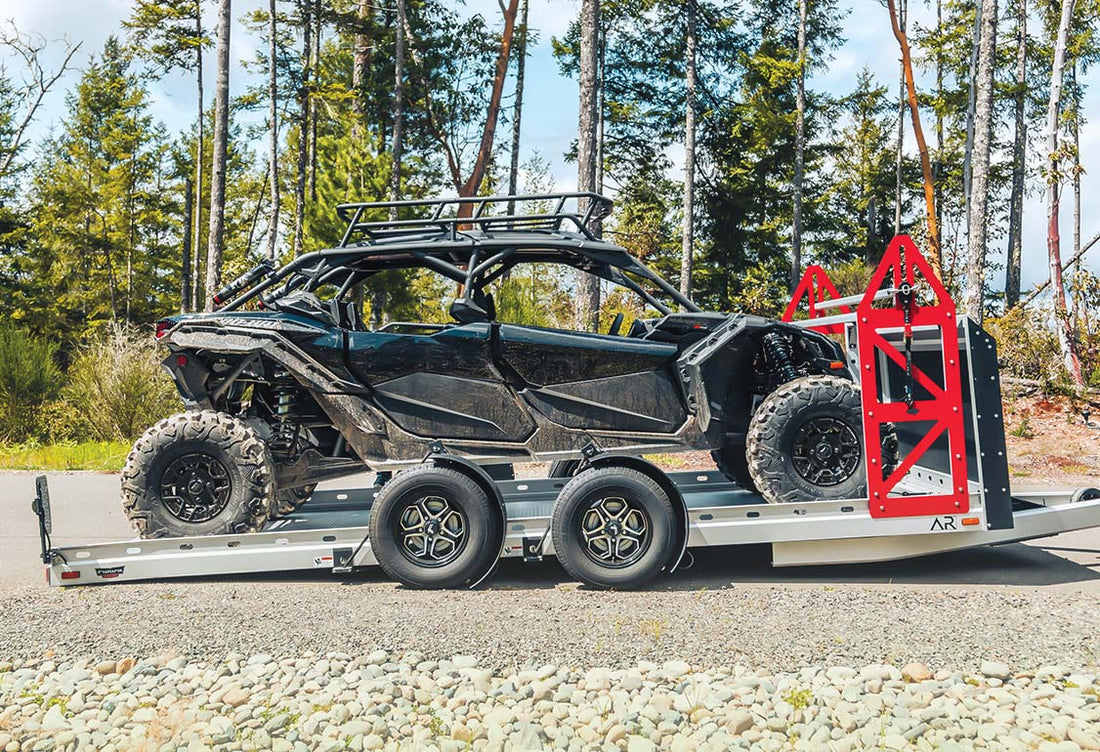Image Credit: Brandon Woyshnis - Stock.Adobe.com
Welcome to our comprehensive guide on how to expertly tie down a UTV on a trailer for your upcoming adventure! We understand the importance of road safety for both you and fellow motorists, so we've crafted this article to walk you through the process with precision and excitement. Let's dive in and discover the secrets to securely fastening your UTV!
Step 1: Achieve Perfect Weight Distribution
The journey to a safe trailer ride begins with loading your UTV onto the trailer with finesse. The key is to ensure an even weight distribution that guarantees optimal stability. By positioning the heaviest part of your side-by-side over the trailer axle, typically the rear due to the engine placement, you establish the foundation for a balanced load. Gently bring your machine forward, inching it closer to the front of the trailer, until you achieve the desired weight distribution. A golden rule to remember: aim for 30% of the weight to rest at the tongue (the trailer's front end). This meticulous weight distribution plays a crucial role in mitigating sway, be it strong gusts of wind or unexpected maneuvers, providing you with confidence and control.
Step 2: Choose Your Tying Method
You have three fantastic options to secure your UTV on the trailer. Let's explore each method, ensuring you find the perfect fit for your needs.
- Four-Point System
- Wheel Chock Strap-Down
- Tire Bonnets
Renowned for its effectiveness, the four-point system remains a top choice for UTV enthusiasts. Gather four ratchet tie-down straps and identify four strategic attachment points on your side-by-side. Ideally, these anchor points should be situated at the lower sections of your vehicle. Place two straps on the front corners and the remaining two on the rear corners. By doing so, you create a force that firmly secures your UTV in place. With the straps securely fastened to your vehicle, connect each one to an anchoring spot on the trailer. Utilize the ratchets to tighten each strap, eliminating any slack. If excess strap length remains, roll it up neatly to prevent it from flailing during your journey. Remember, it's crucial to avoid placing the straps over sharp metal edges, as this could compromise their integrity. Additionally, ensure your straps possess a combined working limit that exceeds the weight of your vehicle, providing a sturdy and reliable hold.
For a robust tying method, the wheel chock strap-down technique offers excellent stability. Equip yourself with four pairs of wheel chocks and four reliable ratchet straps. Wheel chocks are specialized plates designed to secure your UTV's tires to the trailer bed. Position each wheel between a pair of wheel chocks, with one chock at the front and the other at the back. Once aligned, employ the ratchet straps to tightly secure the tires to the trailer. Begin by laying the strap down the center of the tire, then lock one end onto the front chock using the metal buckle. Repeat the process for the rear part of the tire, employing the ratchet to achieve optimal tension. Apply this method to all wheels, ensuring a firm grip and immovable UTV.
Similar to the wheel chock system, the tire bonnet method provides an alternative approach. Tire bonnets utilize three straps per wheel, adding an extra layer of security. The central strap drapes over the tire, enveloping the top portion. The remaining two straps connect to the middle strap, fastening the wheel to the trailer bed. This method requires the installation of mounting tracks on each side of the trailer bed to serve as anchor points for the straps. The adjustable nature of tire bonnet straps allows compatibility with a wide range of wheel sizes, accommodating UTVs with 26 to 36-inch wheels. Embrace this method for its versatility and adaptability to suit your specific UTV and trailer setup.
Step 3: Double-Check for Peace of Mind
Once you have securely tied down your UTV, take a moment to double-check that everything is perfectly in place. Carefully inspect each tie-down strap, ensuring they are tightly secured and show no signs of looseness. To further validate the stability, gently rock your machine from side to side, confirming its immovability. Once satisfied with the firm anchoring, lift the trailer gate and securely lock it. Additionally, give the trailer hitch a final inspection, guaranteeing all components are correctly attached and ready for the adventure ahead.
Enhance Protection with a UTV Cover
While tying down your UTV is crucial, going the extra mile to protect your vehicle is a testament to your dedication. Consider utilizing a trailerable UTV cover to shield your machine during transportation. Let's explore the benefits of covering your UTV while on the road:
- Increased Longevity: Shield your UTV from the sun's harsh rays, extending its lifespan and preserving its pristine condition.
- Weather Resistance: Guard your UTV against rain, snow, and other elements, minimizing the risk of corrosion and rust.
- Preserve Paintwork: Protect your UTV's vibrant paint job from natural hazards such as bird droppings and debris.
- Convenience and Portability: Lightweight and foldable, a trailerable UTV cover is effortless to store and carry on your trips, ensuring hassle-free adventures.
Recap: Your Gateway to a Secure Getaway
Mastering the art of tying down a UTV on a trailer is an invaluable skill for avid road trippers. Although practice may be required, rest assured that the process becomes second nature over time. Remember these three essential steps: achieve even weight distribution during loading, employ a reliable tying method using four anchor points, and finalize your preparations by ensuring everything is securely fastened. And don't forget to enhance the protection of your UTV with a trailerable cover. Now, with your UTV secured and your mind at ease, it's time to embark on your much-anticipated adventure. Enjoy the thrill of the open road!

 HELP
HELP  TRACK ORDER
TRACK ORDER 

